Qiang Huang
Feature Space Adaptation for Robust Model Fine-Tuning
Oct 22, 2025



Abstract:Catastrophic forgetting is a common issue in model fine-tuning, especially when the downstream domain contains limited labeled data or differs greatly from the pre-training distribution. Existing parameter-efficient fine-tuning methods operate in the weight space by modifying or augmenting the pre-trained model's parameters, which can yield models overly specialized to the available downstream data. To mitigate the risk of overwriting pre-trained knowledge and enhance robustness, we propose to fine-tune the pre-trained model in the feature space. Two new fine-tuning methods are proposed: LoRFA (Low-Rank Feature Adaptation) and VeFA (Vector-Based Feature Adaptation). Feature space adaptation is inspired by the idea of effect equivalence modeling (EEM) of downstream lurking variables causing distribution shifts, which posits that unobserved factors can be represented as the total equivalent amount on observed features. By compensating for the effects of downstream lurking variables via a lightweight feature-level transformation, the pre-trained representations can be preserved, which improves model generalization under distribution shift. We evaluate LoRFA and VeFA versus LoRA on image classification, NLU, and NLG, covering both standard fine-tuning metrics and robustness. Feature space adaptation achieves comparable fine-tuning results and consistently stronger robustness.
Explosive Output to Enhance Jumping Ability: A Variable Reduction Ratio Design Paradigm for Humanoid Robots Knee Joint
Jun 14, 2025Abstract:Enhancing the explosive power output of the knee joints is critical for improving the agility and obstacle-crossing capabilities of humanoid robots. However, a mismatch between the knee-to-center-of-mass (CoM) transmission ratio and jumping demands, coupled with motor performance degradation at high speeds, restricts the duration of high-power output and limits jump performance. To address these problems, this paper introduces a novel knee joint design paradigm employing a dynamically decreasing reduction ratio for explosive output during jump. Analysis of motor output characteristics and knee kinematics during jumping inspired a coupling strategy in which the reduction ratio gradually decreases as the joint extends. A high initial ratio rapidly increases torque at jump initiation, while its gradual reduction minimizes motor speed increments and power losses, thereby maintaining sustained high-power output. A compact and efficient linear actuator-driven guide-rod mechanism realizes this coupling strategy, supported by parameter optimization guided by explosive jump control strategies. Experimental validation demonstrated a 63 cm vertical jump on a single-joint platform (a theoretical improvement of 28.1\% over the optimal fixed-ratio joints). Integrated into a humanoid robot, the proposed design enabled a 1.1 m long jump, a 0.5 m vertical jump, and a 0.5 m box jump.
Text Embeddings Should Capture Implicit Semantics, Not Just Surface Meaning
Jun 10, 2025Abstract:This position paper argues that the text embedding research community should move beyond surface meaning and embrace implicit semantics as a central modeling goal. Text embedding models have become foundational in modern NLP, powering a wide range of applications and drawing increasing research attention. Yet, much of this progress remains narrowly focused on surface-level semantics. In contrast, linguistic theory emphasizes that meaning is often implicit, shaped by pragmatics, speaker intent, and sociocultural context. Current embedding models are typically trained on data that lacks such depth and evaluated on benchmarks that reward the capture of surface meaning. As a result, they struggle with tasks requiring interpretive reasoning, speaker stance, or social meaning. Our pilot study highlights this gap, showing that even state-of-the-art models perform only marginally better than simplistic baselines on implicit semantics tasks. To address this, we call for a paradigm shift: embedding research should prioritize more diverse and linguistically grounded training data, design benchmarks that evaluate deeper semantic understanding, and explicitly frame implicit meaning as a core modeling objective, better aligning embeddings with real-world language complexity.
PRISM: A Framework for Producing Interpretable Political Bias Embeddings with Political-Aware Cross-Encoder
May 30, 2025Abstract:Semantic Text Embedding is a fundamental NLP task that encodes textual content into vector representations, where proximity in the embedding space reflects semantic similarity. While existing embedding models excel at capturing general meaning, they often overlook ideological nuances, limiting their effectiveness in tasks that require an understanding of political bias. To address this gap, we introduce PRISM, the first framework designed to Produce inteRpretable polItical biaS eMbeddings. PRISM operates in two key stages: (1) Controversial Topic Bias Indicator Mining, which systematically extracts fine-grained political topics and their corresponding bias indicators from weakly labeled news data, and (2) Cross-Encoder Political Bias Embedding, which assigns structured bias scores to news articles based on their alignment with these indicators. This approach ensures that embeddings are explicitly tied to bias-revealing dimensions, enhancing both interpretability and predictive power. Through extensive experiments on two large-scale datasets, we demonstrate that PRISM outperforms state-of-the-art text embedding models in political bias classification while offering highly interpretable representations that facilitate diversified retrieval and ideological analysis. The source code is available at https://github.com/dukesun99/ACL-PRISM.
Don't Reinvent the Wheel: Efficient Instruction-Following Text Embedding based on Guided Space Transformation
May 30, 2025
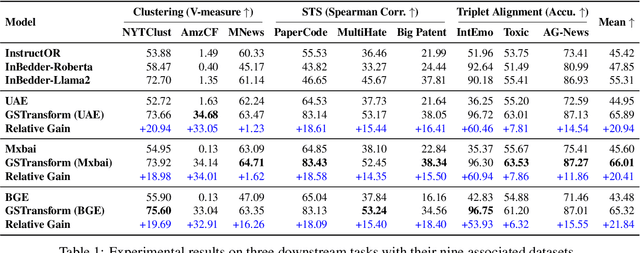
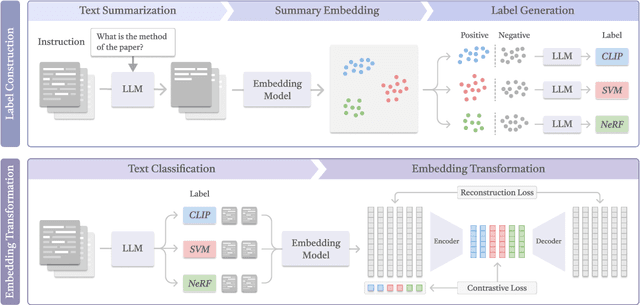

Abstract:In this work, we investigate an important task named instruction-following text embedding, which generates dynamic text embeddings that adapt to user instructions, highlighting specific attributes of text. Despite recent advancements, existing approaches suffer from significant computational overhead, as they require re-encoding the entire corpus for each new instruction. To address this challenge, we propose GSTransform, a novel instruction-following text embedding framework based on Guided Space Transformation. Our key observation is that instruction-relevant information is inherently encoded in generic embeddings but remains underutilized. Instead of repeatedly encoding the corpus for each instruction, GSTransform is a lightweight transformation mechanism that adapts pre-computed embeddings in real time to align with user instructions, guided by a small amount of text data with instruction-focused label annotation. We conduct extensive experiments on three instruction-awareness downstream tasks across nine real-world datasets, demonstrating that GSTransform improves instruction-following text embedding quality over state-of-the-art methods while achieving dramatic speedups of 6~300x in real-time processing on large-scale datasets. The source code is available at https://github.com/YingchaojieFeng/GSTransform.
A Token is Worth over 1,000 Tokens: Efficient Knowledge Distillation through Low-Rank Clone
May 19, 2025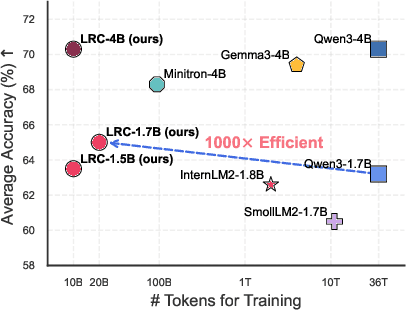



Abstract:Training high-performing Small Language Models (SLMs) remains costly, even with knowledge distillation and pruning from larger teacher models. Existing work often faces three key challenges: (1) information loss from hard pruning, (2) inefficient alignment of representations, and (3) underutilization of informative activations, particularly from Feed-Forward Networks (FFNs). To address these challenges, we introduce Low-Rank Clone (LRC), an efficient pre-training method that constructs SLMs aspiring to behavioral equivalence with strong teacher models. LRC trains a set of low-rank projection matrices that jointly enable soft pruning by compressing teacher weights, and activation clone by aligning student activations, including FFN signals, with those of the teacher. This unified design maximizes knowledge transfer while removing the need for explicit alignment modules. Extensive experiments with open-source teachers (e.g., Llama-3.2-3B-Instruct, Qwen2.5-3B/7B-Instruct) show that LRC matches or surpasses state-of-the-art models trained on trillions of tokens--while using only 20B tokens, achieving over 1,000x training efficiency. Our codes and model checkpoints are available at https://github.com/CURRENTF/LowRankClone and https://huggingface.co/collections/JitaiHao/low-rank-clone-lrc-6828389e96a93f1d4219dfaf.
PathOrchestra: A Comprehensive Foundation Model for Computational Pathology with Over 100 Diverse Clinical-Grade Tasks
Mar 31, 2025Abstract:The complexity and variability inherent in high-resolution pathological images present significant challenges in computational pathology. While pathology foundation models leveraging AI have catalyzed transformative advancements, their development demands large-scale datasets, considerable storage capacity, and substantial computational resources. Furthermore, ensuring their clinical applicability and generalizability requires rigorous validation across a broad spectrum of clinical tasks. Here, we present PathOrchestra, a versatile pathology foundation model trained via self-supervised learning on a dataset comprising 300K pathological slides from 20 tissue and organ types across multiple centers. The model was rigorously evaluated on 112 clinical tasks using a combination of 61 private and 51 public datasets. These tasks encompass digital slide preprocessing, pan-cancer classification, lesion identification, multi-cancer subtype classification, biomarker assessment, gene expression prediction, and the generation of structured reports. PathOrchestra demonstrated exceptional performance across 27,755 WSIs and 9,415,729 ROIs, achieving over 0.950 accuracy in 47 tasks, including pan-cancer classification across various organs, lymphoma subtype diagnosis, and bladder cancer screening. Notably, it is the first model to generate structured reports for high-incidence colorectal cancer and diagnostically complex lymphoma-areas that are infrequently addressed by foundational models but hold immense clinical potential. Overall, PathOrchestra exemplifies the feasibility and efficacy of a large-scale, self-supervised pathology foundation model, validated across a broad range of clinical-grade tasks. Its high accuracy and reduced reliance on extensive data annotation underline its potential for clinical integration, offering a pathway toward more efficient and high-quality medical services.
Unlocking adaptive digital pathology through dynamic feature learning
Dec 29, 2024



Abstract:Foundation models have revolutionized the paradigm of digital pathology, as they leverage general-purpose features to emulate real-world pathological practices, enabling the quantitative analysis of critical histological patterns and the dissection of cancer-specific signals. However, these static general features constrain the flexibility and pathological relevance in the ever-evolving needs of clinical applications, hindering the broad use of the current models. Here we introduce PathFiT, a dynamic feature learning method that can be effortlessly plugged into various pathology foundation models to unlock their adaptability. Meanwhile, PathFiT performs seamless implementation across diverse pathology applications regardless of downstream specificity. To validate PathFiT, we construct a digital pathology benchmark with over 20 terabytes of Internet and real-world data comprising 28 H\&E-stained tasks and 7 specialized imaging tasks including Masson's Trichrome staining and immunofluorescence images. By applying PathFiT to the representative pathology foundation models, we demonstrate state-of-the-art performance on 34 out of 35 tasks, with significant improvements on 23 tasks and outperforming by 10.20% on specialized imaging tasks. The superior performance and versatility of PathFiT open up new avenues in computational pathology.
A General Framework for Producing Interpretable Semantic Text Embeddings
Oct 04, 2024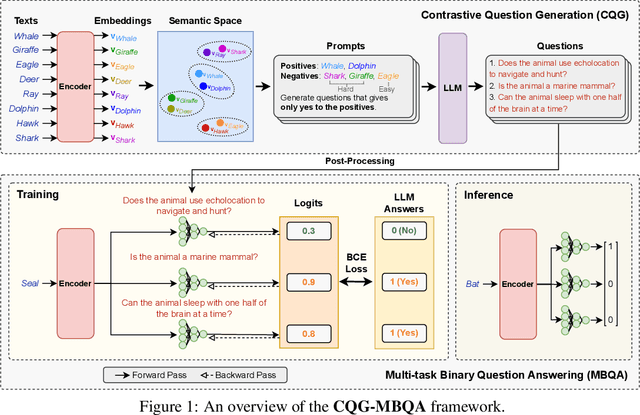

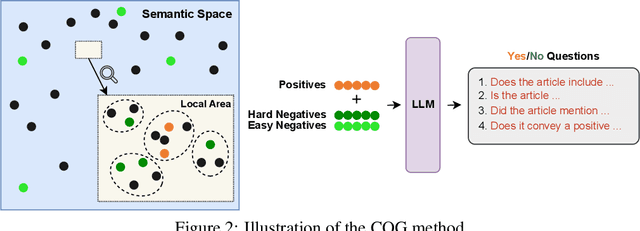
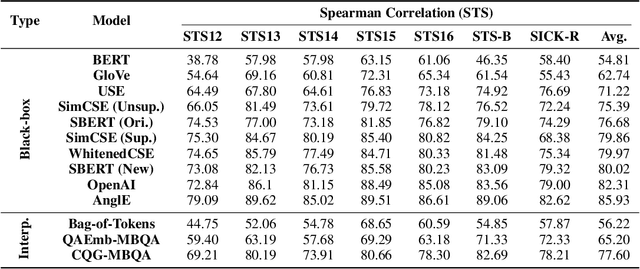
Abstract:Semantic text embedding is essential to many tasks in Natural Language Processing (NLP). While black-box models are capable of generating high-quality embeddings, their lack of interpretability limits their use in tasks that demand transparency. Recent approaches have improved interpretability by leveraging domain-expert-crafted or LLM-generated questions, but these methods rely heavily on expert input or well-prompt design, which restricts their generalizability and ability to generate discriminative questions across a wide range of tasks. To address these challenges, we introduce \algo{CQG-MBQA} (Contrastive Question Generation - Multi-task Binary Question Answering), a general framework for producing interpretable semantic text embeddings across diverse tasks. Our framework systematically generates highly discriminative, low cognitive load yes/no questions through the \algo{CQG} method and answers them efficiently with the \algo{MBQA} model, resulting in interpretable embeddings in a cost-effective manner. We validate the effectiveness and interpretability of \algo{CQG-MBQA} through extensive experiments and ablation studies, demonstrating that it delivers embedding quality comparable to many advanced black-box models while maintaining inherently interpretability. Additionally, \algo{CQG-MBQA} outperforms other interpretable text embedding methods across various downstream tasks.
Retrofitting Temporal Graph Neural Networks with Transformer
Sep 10, 2024



Abstract:Temporal graph neural networks (TGNNs) outperform regular GNNs by incorporating time information into graph-based operations. However, TGNNs adopt specialized models (e.g., TGN, TGAT, and APAN ) and require tailored training frameworks (e.g., TGL and ETC). In this paper, we propose TF-TGN, which uses Transformer decoder as the backbone model for TGNN to enjoy Transformer's codebase for efficient training. In particular, Transformer achieves tremendous success for language modeling, and thus the community developed high-performance kernels (e.g., flash-attention and memory-efficient attention) and efficient distributed training schemes (e.g., PyTorch FSDP, DeepSpeed, and Megatron-LM). We observe that TGNN resembles language modeling, i.e., the message aggregation operation between chronologically occurring nodes and their temporal neighbors in TGNNs can be structured as sequence modeling. Beside this similarity, we also incorporate a series of algorithm designs including suffix infilling, temporal graph attention with self-loop, and causal masking self-attention to make TF-TGN work. During training, existing systems are slow in transforming the graph topology and conducting graph sampling. As such, we propose methods to parallelize the CSR format conversion and graph sampling. We also adapt Transformer codebase to train TF-TGN efficiently with multiple GPUs. We experiment with 9 graphs and compare with 2 state-of-the-art TGNN training frameworks. The results show that TF-TGN can accelerate training by over 2.20 while providing comparable or even superior accuracy to existing SOTA TGNNs. TF-TGN is available at https://github.com/qianghuangwhu/TF-TGN.
 Add to Chrome
Add to Chrome Add to Firefox
Add to Firefox Add to Edge
Add to Edge